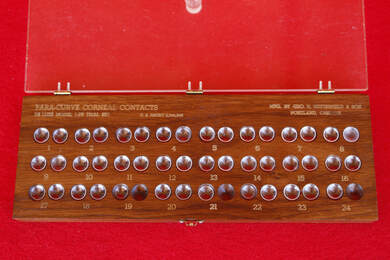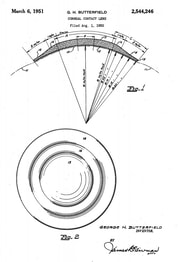George H. Butterfield (1895-1973)
The George Butterfield Story
George Butterfield, from Portland, OR is given credit in 1950 for adding peripheral curves to the posterior lens surface, introducing the modern concept of fitting the lens on the Ks.* (previously, Tuohy's design was a monocurve)
His design was followed soon after by others such as Obrig Laboratories in New York, Breger-Mueller-Welt in Chicago, and the Plastic Contact Lens Co (Wesley-Jessen) also from Chicago, who designed their PMMA lenses thinner and smaller.
Butterfield had a patent dispute with with Solex (Tuohy's company), the Plastic Contact Lens Company (new owner's of Solex) and others whereby Butterfield lost. (1)
In the court documents it was surmised that "In summary, we hold that the Butterfield patent, No. 2,544,246, calls for a bi-curved corneal lens, the central curve of which conforms to the curvature of the central area of the cornea with a peripheral curve corresponding in curvature to that of the peripheral area of the cornea. Since such a lens is concededly unwearable and useless, we find the patent to be invalid"
* adapted from Contact Lens Pioneers Jack Schaeffer, O.D., and Jan Beiting https://www.reviewofoptometry.com/article/contact-lens-pioneers-15390
1) Butterfield v. Oculus Contact Lens Company, 332 F. Supp. 750 (N.D. Ill. 1971) Decided Oct 6, 1971
George Butterfield, from Portland, OR is given credit in 1950 for adding peripheral curves to the posterior lens surface, introducing the modern concept of fitting the lens on the Ks.* (previously, Tuohy's design was a monocurve)
His design was followed soon after by others such as Obrig Laboratories in New York, Breger-Mueller-Welt in Chicago, and the Plastic Contact Lens Co (Wesley-Jessen) also from Chicago, who designed their PMMA lenses thinner and smaller.
Butterfield had a patent dispute with with Solex (Tuohy's company), the Plastic Contact Lens Company (new owner's of Solex) and others whereby Butterfield lost. (1)
In the court documents it was surmised that "In summary, we hold that the Butterfield patent, No. 2,544,246, calls for a bi-curved corneal lens, the central curve of which conforms to the curvature of the central area of the cornea with a peripheral curve corresponding in curvature to that of the peripheral area of the cornea. Since such a lens is concededly unwearable and useless, we find the patent to be invalid"
* adapted from Contact Lens Pioneers Jack Schaeffer, O.D., and Jan Beiting https://www.reviewofoptometry.com/article/contact-lens-pioneers-15390
1) Butterfield v. Oculus Contact Lens Company, 332 F. Supp. 750 (N.D. Ill. 1971) Decided Oct 6, 1971
Paracurve Corneal Contact Lens Trial Set, circa 1955
Butterfield Corneal Contact Lens Patent 1951
(click here or on the above image for full patent)
(click here or on the above image for full patent)


